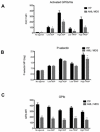Differences in platelet function in patients with acute myeloid leukemia and myelodysplasia compared to equally thrombocytopenic patients with immune thrombocytopenia
- PMID: 21920014
- PMCID: PMC3210015
- DOI: 10.1111/j.1538-7836.2011.04506.x
Differences in platelet function in patients with acute myeloid leukemia and myelodysplasia compared to equally thrombocytopenic patients with immune thrombocytopenia
Abstract
Background: Severe thrombocytopenia is a major risk factor for hemorrhage, but platelet function and bleeding risk at low platelet counts are poorly understood, because of the limitations of platelet function testing at very low platelet counts.
Objectives: To examine and compare platelet function in severely thrombocytopenic patients with acute myeloid leukemia (AML) or myelodysplasia (MDS) with that in patients with immune thrombocytopenia (ITP).
Methods: Whole blood flow cytometric measurement of platelet activation and platelet reactivity to agonists was correlated with the immature platelet fraction (IPF) and bleeding symptoms.
Results: Patients with AML/MDS had smaller platelets, lower IPF and substantially lower platelet surface expression of activated glycoprotein (GP)IIb-IIIa and GPIb, both with and without addition of ex vivo ADP or thrombin receptor-activating peptide, than patients with ITP. In both ITP and AML/MDS patients, increased platelet surface GPIb on circulating platelets and expression of activated GPIIb-IIIa and GPIb on ex vivo activated platelets correlated with a higher IPF. Whereas platelet reactivity was higher for AML/MDS patients with bleeding than for those with no bleeding, platelet reactivity was lower for ITP patients with bleeding than for those with no bleeding.
Conclusions: AML/MDS patients have lower in vivo platelet activation and ex vivo platelet reactivity than patients with ITP. The proportion of newly produced platelets correlates with the expression of platelet surface markers of activation. These differences might contribute to differences in bleeding tendency between AML/MDS and ITP patients. This study is the first to define differences in platelet function between AML/MDS patients and ITP patients with equivalent degrees of thrombocytopenia.
© 2011 International Society on Thrombosis and Haemostasis.
Figures





Comment in
-
Differences in platelet function in patients with acute myeloid leukemia and myelodysplasia compared to equally thrombocytopenic patients with immune thrombocytopenia: a rebuttal.J Thromb Haemost. 2013 May;11(5):1001-2. doi: 10.1111/jth.12132. J Thromb Haemost. 2013. PMID: 23311900 No abstract available.
-
Differences in platelet function in patients with acute myeloid leukemia and myelodysplasia compared to equally thrombocytopenic patients with immune thrombocytopenia: a reply to a rebuttal.J Thromb Haemost. 2013 May;11(5):1002-3. doi: 10.1111/jth.12191. J Thromb Haemost. 2013. PMID: 23496753 No abstract available.
References
-
- Gaydos LA, Freireich EJ, Mantel N. The quantitative relation between platelet count and hemorrhage in patients with acute leukemia. N Engl J Med. 1962;266:905–9. - PubMed
-
- Friedmann AM, Sengul H, Lehmann H, Schwartz C, Goodman S. Do basic laboratory tests or clinical observations predict bleeding in thrombocytopenic oncology patients? A reevaluation of prophylactic platelet transfusions. Transfus Med Rev. 2002;16:34–45. - PubMed
-
- Slichter SJ, Kaufman RM, Assmann SF, McCullough J, Triulzi DJ, Strauss RG, Gernsheimer TB, Ness PM, Brecher ME, Josephson CD, Konkle BA, Woodson RD, Ortel TL, Hillyer CD, Skerrett DL, McCrae KR, Sloan SR, Uhl L, George JN, Aquino VM, Manno CS, McFarland JG, Hess JR, Leissinger C, Granger S. Dose of prophylactic platelet transfusions and prevention of hemorrhage. N Engl J Med. 2010;362:600–13. - PMC - PubMed
Publication types
MeSH terms
Substances
Grants and funding
LinkOut - more resources
Full Text Sources
Medical
Research Materials
Miscellaneous

